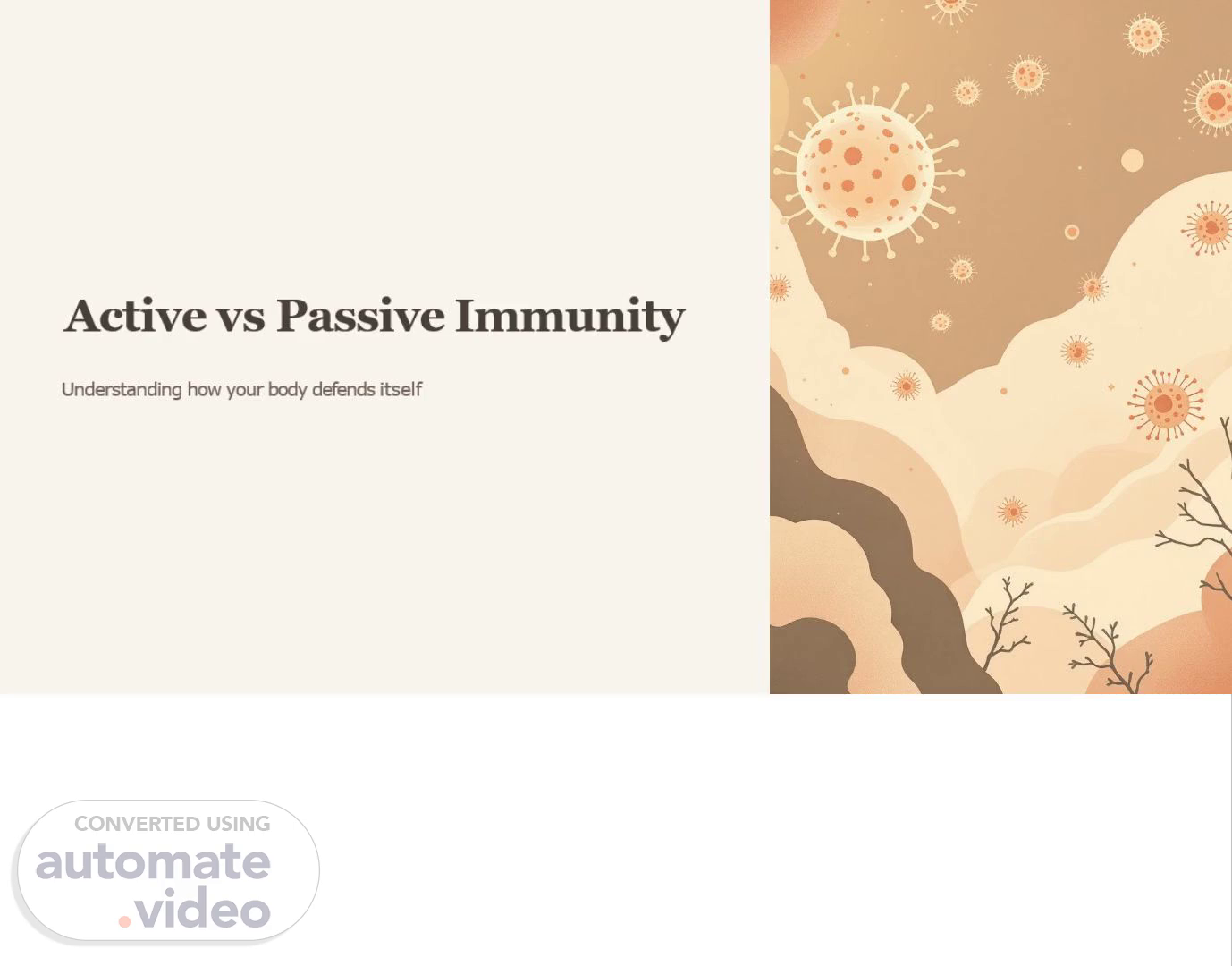Scene 1 (0s)
[Audio] Active vs Passive Immunity Understanding how your body defends itself Hello everyone. My name is Harshitha, registration number 76, from the Cloud Computing department, section B. Today, for our course "Introduction to Computational Biology," I'll be discussing a fundamental concept: Active versus Passive Immunity. We all talk about 'being immune' to something, but how does our body actually achieve this? It turns out, there are two very different ways our body defends itself, and understanding them is key to understanding our own health..
Scene 2 (37s)
[Audio] What is Active Immunity? Self-Generated Defense Your immune system creates its own antibodies after pathogen exposure Natural or Artificial Develops through infection recovery or vaccination Long-Term Memory Builds immunological memory for lasting, sometimes lifelong protection Delayed but Durable Takes days to weeks to develop but provides robust, enduring defense What is Active Immunity? First, let's talk about Active Immunity. This is what most of us typically think of when we hear the word 'immunity.' The key idea here is that it's a self-generated defense. 3 This means your own immune system is the one doing the work. It actively creates its own antibodies after it's been exposed to a pathogen, like a virus or bacteria. There are two main ways we can develop this active immunity: naturally or artificially. Natural active immunity is what you get after you've been sick and have recovered from an infection. For example, if you get chickenpox, your body fights it off, and for the rest of your life, your immune system "remembers" that specific virus and can defeat it before it makes you sick again. Artificial active immunity is what we get from vaccination. A vaccine introduces a safe, weakened, or partial form of the pathogen to your body. This isn't enough to make you truly sick, but it's enough to trigger your immune system to build a full-scale defense. It's like a training manual for your body. The most important feature of active immunity is that it creates long-term memory. It builds what we call "immunological memory," which provides lasting, and sometimes even lifelong, protection. However, this powerful protection isn't instant. It's delayed but durable. After an infection or a vaccination, it can take several days or even weeks for your body to develop this full defense. But the wait is worth it, because the defense it builds is robust and stays with you for a long time..
Scene 3 (2m 52s)
[Audio] What is Passive Immunity? Borrowed Protection Antibodies made outside your body, transferred to you Common Sources Maternal antibodies via placenta or breastmilk, immune globulin treatments Instant Shield Provides immediate protection without immune response delay Temporary Defense Lasts weeks to months only4no immunological memory created What is Passive Immunity? Now, let's look at the other side of the coin: Passive Immunity. If active immunity is about making your own defenses, passive immunity is about borrowing them. With passive immunity, you are given antibodies that were made outside your own body. Your immune system does no work at all; it simply receives this pre-made protection. Where does this "borrowed" protection come from? The most common and important natural example is maternal antibodies. A baby receives antibodies from its mother through the placenta before it's born, and then continues to receive them through breastmilk after birth. This is why breastfeeding is so important, as it gives the newborn a temporary defense system while its own is still developing. An artificial source would be immune globulin treatments. This is a medical therapy where a person who has been exposed to a disease (like rabies or tetanus) can be given an injection of antibodies to fight it off immediately. The biggest advantage of passive immunity is that it provides an instant shield. There is no delay. The protection is immediate, which is critical in life-threatening situations. But, as you might guess, there's a trade-off. This is only a temporary defense. Because your body didn't make the antibodies, it doesn't create any immunological memory. This borrowed protection is short-term, lasting only for a few weeks or months until the antibodies naturally break down and are cleared from your system..
Scene 4 (4m 53s)
[Audio] Summary: Active vs Passive Immunity Feature Active Immunity Passive Immunity Antibody Source Produced by your own immune system Transferred from another source Onset of Protection Delayed (days to weeks) Immediate Duration Long-lasting (years to lifetime) Short-term (weeks to months) Memory Created Yes No Examples Infection recovery, vaccines Maternal antibodies, antibody therapy Key Takeaway: Active immunity builds your body's defense; passive immunity offers quick, temporary shield. So, to quickly summarize the key differences between the two: Antibody Source: In Active immunity, antibodies are produced by your own immune system. In Passive immunity, they are transferred from another source. Onset: Active immunity is delayed, taking days or weeks. Passive immunity is immediate. Duration: Active immunity is long-lasting—think years to a lifetime. Passive immunity is short-term—only weeks to months. Memory: This is the big one. Active immunity creates immunological memory. Passive immunity does not. Examples: Active immunity comes from infection recovery or vaccines. Passive immunity comes from maternal antibodies or antibody therapy. The key takeaway is this: Active immunity builds your body's own defense factory, while passive immunity gives you a quick, temporary shield. Understanding this difference is crucial for appreciating how vaccines protect us for the long haul, and why treatments like maternal antibodies are so essential for giving newborns a safe start in life. Thank you..
